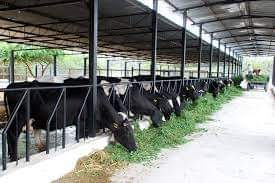AGALACTIA IN DAIRY CATTLE -TREATMENT
Agalactia is the absence of milk secretion in a female that has just
given birth. It represents either a failure of milk production or fail-
ure of the release of milk into the teat canal. Normally, milk is not
continuously released after it is produced. Instead, it is stored in the
mammary gland (breast tissue) until the gland is stimulated to release
the milk, which is called milk let-down. Lactation is the production
of milk; it usually begins just before the mother gives birth.
Causes————–
A rare cause of agalactia is complete failure of the mammary glands to develop in the female. Why breast tissue does not develop is not well understood.
Milk let-down may fail to occur from either hormonal causes or psychological abnormalities. First-time pregnancies in young animals or the presence of anxiety or nervousness may prevent the mother from being relaxed enough to allow the litter to suckle. In highly stressed animals, adrenalin is secreted and interferes with the hormone, oxytocin, which enhances milk let-down.
Generalized debilitating conditions, such as infection of the uterus, mammary glands, or other systemic organs, can lead to agalactia. Nutritional deficiency of the dam can cause agalactia but is uncommon in most cattle on well-balanced diets.
.
Etiology : 1. When the animal is in oestrus
- Nutritional disorders
- Endometrits and other reproductive disorders
- Systemic diseases
- Death of calf and consequent let down problem
- Milk fever and acetonemia
- Hormonal imbalance
- Edema and congestion
- Toxins and Pesticides
- Summer stress and drought.
- Worm burden especially Fasciolasis, Strongylosis etc.
Clinical Signs————
The mammary glands of the mother may or may not be well devel-
oped. The offspring attempt to suckle the mother but have no suc-
cess in getting milk. Both the mother and offspring may become agitated, and the puppies or kittens may cry continuously.
Diagnostic Tests————
The mammary glands often look normal on close examination, but no milk is visible on evaluation of the teat canal.
Treatment Options—————
It is not possible to treat congenital mammary abnormalities, and affected females should not be bred.
In nervous mothers, tranquilizers may be tried, not only to help them relax but because some tranquilizers also increase milk pro-
duction indirectly. Drugs (such as metoclopramide) that increase the secretion of prolactin, a hormone that helps with milk produc-
tion, may be given. Metoclopramide must be use cautiously, how-
ever, because it may cause hyperactivity or depression.
Suckling by the litter helps stimulate milk let-down. In some instances, when milk production by the mother is adequate, the administration of oxytocin stimulates milk let-down. If the cause of agalactia is poor nutrition or a systemic disease, correction of these conditions may reverse the agalactia.
Follow-up Care and Prognosis———–
In those mothers with no milk production at all, it often is not pos-
sible to reverse the agalactia. In these cases, the offspring must be
hand reared. Your veterinarian may recommend that these females
not be bred again, because the problem may recur with subsequent
pregnancies.
The nervous dam can often be persuaded to allow the offspring to suckle, and milk production may then occur spontaneously. Some of these cattle also respond to oxytocin therapy. For a few days, the offspring may need supplemental feedings. Mothers that suffer from a milk let-down problem may not have the problem with subsequent litters.
AGALCTIA OR DYSAGLACTIA TREATMENT WITH HOMEOPATHY:
Treatment :
- Correct the cause
- Good feeding and management
- Agnus Castus: lc-6c. Due to mental trouble of Mother. Corrects hormonal levels of lactation to increase milk.
- Alfalfa: Q-6c. Improve nutrition and increase quality and quantity of milk.
- Asafoetida: 6c-30c. b.i.d, x 15 days. For delayed appearance of milk in sensitive animals.
- Belladonna: 4x. Milk drawn up, one hour before milking.
- Calcarea Carb:30c. For heavy animals with engorged udder and scanty milk.
- Calcarea Phos: 6c-30c. For undernourished, lean cows. g) Causticum: 200c. Due to excitement of Dams.
- Five Phos: 3x-30c. (Ca, Na, K, Mg and Fe Phosphate).
- Galega: Q-30c. Rapidly increase the quantity and quality of milk in early lactation.
- Ignatia: 200c. Due to death of calf .
- Lactuca Virosa: Q. A true galactogogue that increase milk.
- Lecithin: 12c.Excellent galactagogue. Improve quality and quantity of milk.
- .Dulcamara: 30c. Due to exposure to severe cold.
- Phosphoric Acid: 1c. Corrects stress due to lactation anc increase milk yield.
- Phytolacca: 3x/30c-200c. Udder hard, caked due to wettin.; in rains and cold weather.
- Ricinus Communis: Q-30c. + 5 Phos: 6x. An exceller-: galactagogue.
- Sepia: 30c-200c. For lack of motherly instinct in cows tha: behave indifferently to their calves.
- Silicea: 1M. Due to death of calf.
- Urtica Urens: Q-6c, 30c-200c. Low milk yield without an:, apparent cause. High potency stimulate milk flow (Lov. potency depress milk flow).
- Homeopathic Combination 1. :
Alfaalfa 30
Ricinus com Q
Urtica urens 30
Dose : 5 to 10 drops T.I.D for 1 week to increase the flow
of milk . - Homeopathic Combination 2: Calcarea phos 3x
Calcarea fluor 3x
Nat. mur 3x
Silicea 6x
Dose : 4 pills of each B.I.D. till improvement - Homeopathic Combination 3: Calcarea Phos
Ricinus com
Urtica urens
Ferrum phos
Kali phos
Nat. phos
Mag phos aa 30, aa 3ml
Made up to 100ml with vimeral liquid.
Indications : to increase the flow of milk
Dose : 2 – 5 ml B.I.D. / 10-15 days - Homeopathic Combination 4: Urtica urens Q
Calcarea carb 30
Calcarea fluor 30
Calcarea phos 30
Silicea 30
Compiled & Shared by- Team, LITD (Livestock Institute of Training & Development)
Image-Courtesy-Google
Reference-On Request.


